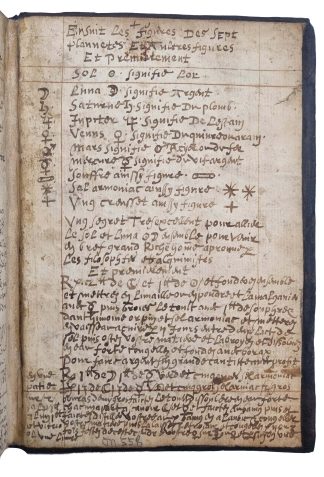FONTAINE, Denis de. [with] GLAREANUS, Henricus.
WITH C16 ALCHEMICAL MS
Medical and alchemical recipes. [with] Helvetiae descriptio.
Manuscript on paper, France, before 1608. [with], Basel, J. Parcus, 1554.£12,500.00
8vo. 11 ms ll.; pp. 93, [1] + 13 unnumbered ll.; 11 ms ll. Roman letter, with Italic. 13 small woodcut arms of Swiss cities, woodcut printer’s device to last, decorated initials and ornaments, 13 half-page woodcut views of Swiss cities (from 1554 German ed.). Ruled in red. Title a little dusty, very light age yellowing. 22 added ll. with extensive annotations (text continuing on front and rear pastedowns) in brown ink, c.1600 secretary hand, in French and Latin, small sketch of distillation equipment. Watermark: pot with handle, crown on top. Small repair to fore-edge of one leaf, affecting few letters. A good copy in c1600 calf, rebacked, a.e.g.. C18 autograph ‘J. Merrick’ and C16 ms ‘Pour [par?] M[onsieu]r Denis De la Fontaine / Cirurgien en la Ville de Grace [Le Havre]’ and a short medical recipe to title of II.
A most interesting C16 ms with medical and alchemical recipes, produced by the physician Denis de la Fontaine (fl.1590s), in Le Havre. It was not unusual to conceal recipes for medical ‘secrets’ within unrelated, non-descript books, to protect them from unwanted readers. The ‘terminus ante quem’ is 1608; it appears in a section, spanning 1570-90, concerning the birth, marriage or death of other de la Fontaines. Denis owned other books with ms additions, c.1590, some with ink views of Le Havre (now at Bib. Mun. of Le Havre and Rouen). Probably, that is why Heinrich Glarean’s book – a most famous poetic chorography of Switzerland, here in the second ed. – was in his library, including 13 charming woodcuts with views of 13 Swiss cities, only present in the 1554 German ed.
Alchemy and medicine blend seamlessly in de la Fontaine’s notes. Among the numerous recipes, including an inked sketch of a copper vessel, are some for oils distilled from metals (e.g., vitriol, antimony), remedies for the plague and pestilential fevers, the preparation of salts, and the calcination of alum and tartar. For each substance, there is an explanation of how to prepare it as well as its therapeutic virtues. None of these appear to come from any specific printed sources. On the rear pastedown, he listed the alchemical signs for the planets and the elements they refer to, and a remedy used by ‘philosophers and alchemists’. Three ‘secrets’ are attributed to experiments by ‘Monsieur de Fournea’ (Fournas?), turning one ounce of silver into two, dated 1584; ‘Monsieur de la Ferrière’, turning one ounce of gold into two, and ‘Monsieur de Bailleul’ to heal various illnesses. The second may be the Huguenot Jean de Ferrières (1520–86), who, during his exile in England, recommended the Italian alchemist G.B. Agnello to Cecil. Half a leaf includes two popular charms, in Latin and French. The first – ‘Anna peperit mariam maria salvatorem…’ – appears in late medieval mss and was used, as here, to help women deliver without pain (see Wogan-Browne, p.49). The second was used ‘against all fevers’: ‘In nomine Dominus… Deus Abraham… fiebvre je te conjure’ – and was listed in the ‘Encyclopédie théologique’ (1849) under ‘exorcisme’ as it sought, through invocations and the imposition of hands, to expel the fever from the body. A most interesting medico-alchemical ms, detailed and copious.
John Merrick was probably the same MD (c.1705-57), fellow of St John’s Oxford, who also owned ‘Course of Chemistry’ (MS 238, 17thC) and other medico-alchemical books and mss now at St John’s library, with his bookplate and autograph (similar to ours, much smaller, and certainly C18).
In stock


![FONTAINE, Denis de. [with] GLAREANUS, Henricus.](https://sokol.co.uk/wp-content/uploads/2024/03/L4344-6.jpg)
![FONTAINE, Denis de. [with] GLAREANUS, Henricus. - Image 2](https://sokol.co.uk/wp-content/uploads/2024/03/L4344-2.jpg)
![FONTAINE, Denis de. [with] GLAREANUS, Henricus. - Image 3](https://sokol.co.uk/wp-content/uploads/2024/03/L4344-5.jpg)
![FONTAINE, Denis de. [with] GLAREANUS, Henricus. - Image 4](https://sokol.co.uk/wp-content/uploads/2024/03/L4344-4.jpg)
![FONTAINE, Denis de. [with] GLAREANUS, Henricus. - Image 5](https://sokol.co.uk/wp-content/uploads/2024/03/L4344-3.jpg)
![FONTAINE, Denis de. [with] GLAREANUS, Henricus. - Image 6](https://sokol.co.uk/wp-content/uploads/2024/03/L4344-1.jpg)
